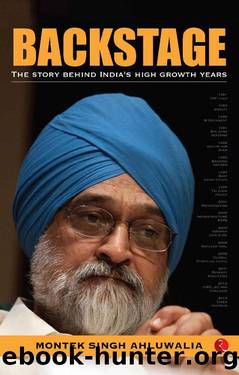BACKSTAGE: The Story behind India’s High Growth Years by Montek Singh Ahluwalia

Author:Montek Singh Ahluwalia [Ahluwalia, Montek Singh]
Language: eng
Format: epub
Published: 2020-02-14T18:30:00+00:00
MY MOVE TO THE PLANNING COMMISSION
Sometime in August 1998, Brajesh Mishra informed me that the Government was ready to make changes at the secretary level, and asked me where I would like to go. I asked if I could be sent to the Planning Commission as a member. I had become increasingly interested in problems of infrastructure development and knew that if we wanted a large programme of investment in infrastructure, we would have to attract PPPs. This required careful policy design and coordination across ministries and I thought the Planning Commission would give me an opportunity to help shape policy in this area. Two days later, my move to the Planning Commission was formally announced; N.K. Singh, who was revenue secretary in the Ministry of Finance, would move to the PMO as secretary to the PM. Shortly thereafter, I was also made a member of the EAC-PM.
I called on Deputy Chairman Jaswant Singh to report for duty and when I expressed my interest in working on infrastructure, I was officially designated as member, infrastructure. I was the only member at the time as Jaswant Singh had not agreed to take on any others. A former cavalry officer with a deep interest in military history and strategy, he was intellectually oriented and easy to interact with. But he had limited interest in the work of the commission and made no secret of it. He had expected to be finance minister but it was apparently scuttled because of opposition from some circles within the broader Sangh Parivar. He had accepted the deputy chairmanship of the Planning Commission with the expectation that the PM would soon give him another assignment.
Soon after I joined the commission, PM Vajpayee, in a public speech delivered at the Associated Chambers of Commerce and Industry of India (ASSOCHAM), announced a new pair of four-to six-lane highways, one running North to South, connecting Srinagar with Kanyakumari at the extreme southern tip, and the other running East to West, connecting Silchar in Assam with Porbandar in Gujarat. The proposed highways were over 7,500 km in length and the idea was particularly ambitious considering most existing National Highways had only two lanes!
B.N. Puri was in charge of the transport division of the commission. He immediately brought to my attention that as there was no budgetary provision for the new programme, there was a serious danger that resources would be diverted from the ongoing upgradation of the so-called Golden Quadrilateral, i.e. the National Highways connecting Delhi, Kolkata, Chennai and Mumbai. This quadrilateral carried the bulk of the road traffic in the country and was much more important than the proposed new alignments, which would have much less traffic for quite some time. The priority should be to upgrade the Golden Quadrilateral to four lanes, with six lanes in certain stretches. I raised this with Jaswant Singh but he was reluctant to take it up with the PM as it would look like he was questioning his announcement.
I offered to try and
Download
This site does not store any files on its server. We only index and link to content provided by other sites. Please contact the content providers to delete copyright contents if any and email us, we'll remove relevant links or contents immediately.
Still Foolin’ ’Em by Billy Crystal(36209)
We're Going to Need More Wine by Gabrielle Union(18911)
Plagued by Fire by Paul Hendrickson(17297)
Pimp by Iceberg Slim(14230)
Molly's Game by Molly Bloom(14029)
Becoming by Michelle Obama(9895)
When Breath Becomes Air by Paul Kalanithi(8271)
Educated by Tara Westover(7888)
The Girl Without a Voice by Casey Watson(7781)
Note to Self by Connor Franta(7592)
The Incest Diary by Anonymous(7518)
How to Be a Bawse: A Guide to Conquering Life by Lilly Singh(7349)
The Space Between by Michelle L. Teichman(6818)
What Does This Button Do? by Bruce Dickinson(6107)
Imperfect by Sanjay Manjrekar(5750)
Permanent Record by Edward Snowden(5688)
A Year in the Merde by Stephen Clarke(5270)
Shoe Dog by Phil Knight(5085)
Promise Me, Dad by Joe Biden(5041)
